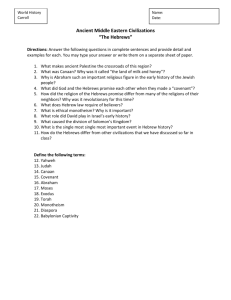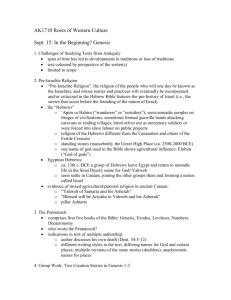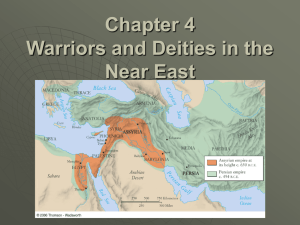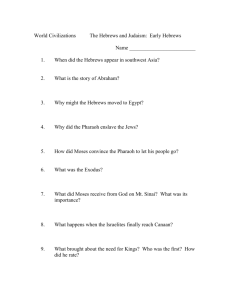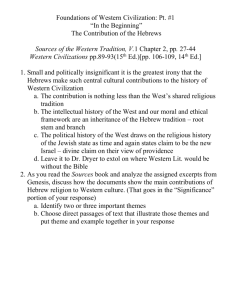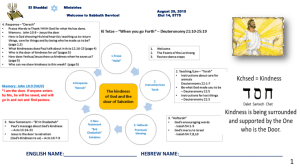CF manual
advertisement
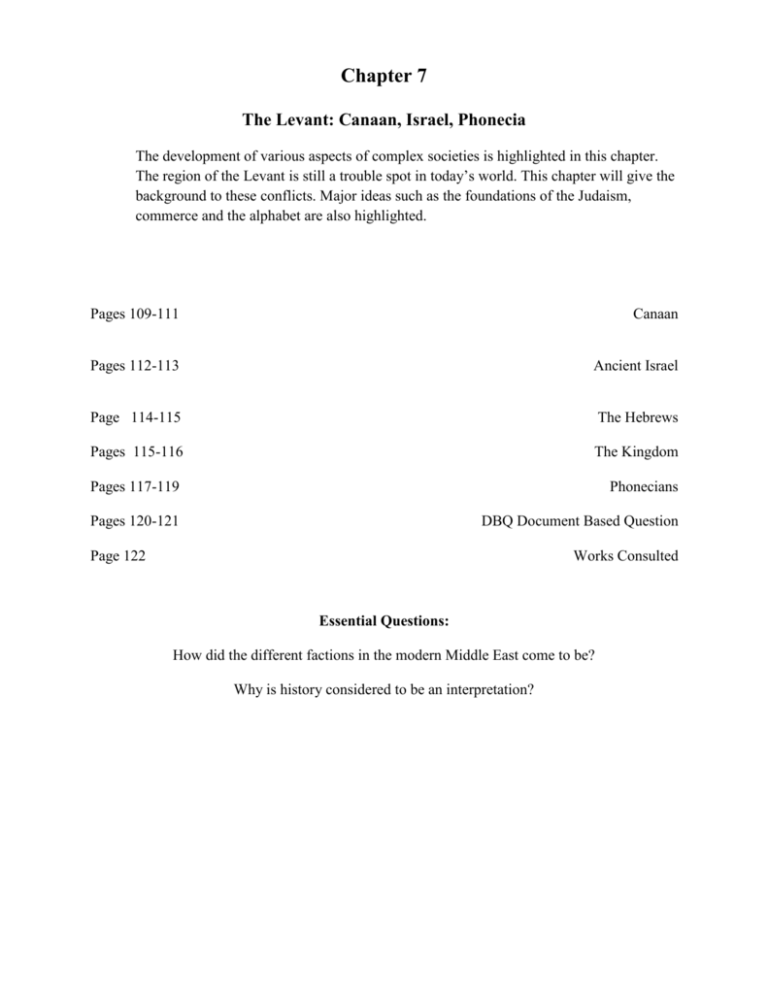
Chapter 7 The Levant: Canaan, Israel, Phonecia The development of various aspects of complex societies is highlighted in this chapter. The region of the Levant is still a trouble spot in today’s world. This chapter will give the background to these conflicts. Major ideas such as the foundations of the Judaism, commerce and the alphabet are also highlighted. Pages 109-111 Canaan Pages 112-113 Ancient Israel Page 114-115 The Hebrews Pages 115-116 The Kingdom Pages 117-119 Phonecians Pages 120-121 DBQ Document Based Question Page 122 Works Consulted Essential Questions: How did the different factions in the modern Middle East come to be? Why is history considered to be an interpretation? Timeline of Levant 80,000 BP Homo Sapiens, crossing Red Sea into Yemen from East Africa, begin to populate world and eliminate other hominids. 10,000 BP/8000 BC Agriculture emerges in Fertile Crescent, region of Middle East incorporating Mesopotamia, Levant, and Egypt (Neolithic Revolution), leading to formation of permanent settlements; 3500 BCE Bronze, strong man-made alloy of copper and tin, invented independently in Middle East and Far East 1500 BC Abraham of Ur in southern Mesopotamia leads Hebrews, a Semitic people, from Sumer to Canaan and then, as result of famine, to Egypt 1200 BC 1050 BC Moses leads Israelites (Hebrews) from Egypt into Canaan Widespread use of iron begins in Mediterranean region; Iron Sea Peoples, who may have been Philistines (from Canaan) invade Mediterranean coasts, destroying Hittite Empire Phoenicians, a Semitic people living in present-day Lebanon and skilled in ancient times as seafaring traders, invent phonetic alphabet, with about two dozen abstract symbols (letters) representing sounds, in contrast to non-alphabetic writing systems. 930 BC Israel and Judah separate into two kingdoms; some time afterward priests in each kingdom begin writing down oral traditions that eventually coalesce into Bible 722 – 720 BC Israel crushed by Assyrians; 10 tribes exiled (Ten Lost Tribes). 586 BC Judah conquered by Babylonia; Jerusalem and First Temple destroyed; most Jews exiled to Babylonia. 538-515 BC Many Jews return from Babylonia; Temple rebuilt. The Levant Cultures Canaan and Ancient Israel Geography The habitable portion of the southern Levant is small but exceedingly diverse. From mountain peaks to the lowest point on the earth, from abundant rainfall to arid desert, the land includes a wide range of habitats. The peak of Mt. Hermon (Picture right) is more than 9,000 feet (2800 m) above sea level, while the Dead Sea is the lowest point on the earth's surface more than 1,300 feet (390 m) below sea level. The climatic variations are largely due to it being a land hemmed in between the Mediterranean Sea to the west and the Arabian Desert to the east. Summers are hot and dry; most precipitation occurs during the relatively cool winters. The dry areas approach desert conditions and can receive as little as 2 inches of rainfall per year. Apart from the Sea of Galilee and the Jordan River valley, there are few lakes or rivers. Most water is found in springs that break through the limestone bedrock covering most of the region. The more humid areas have a mild Mediterranean climate, such as is found in Greece and Italy. These areas receive between 12 and 40 inches of rain per year. The natural vegetation originally consisted of dense oak, pistachio and pine tree forests. Wild wheat, barley and olive trees were also native to this area. Over the millennia, human beings have brought about dramatic changes in the environment. By 8,500 years ago, human intervention had led to plant domestication and by 5,000 years ago, deforestation was well underway. A great variety of animals are known from the Levant and among them are about 100 species of mammals and almost 500 species of birds. Many of the wild beasts of the forest no longer exist today as a result of intensive hunting. Among these animals are the lion, bear, antelope, wild ox, Mesopotamian fallow deer, ostrich, crocodile and hippopotamus. Domesticated animals from the area include the horse, donkey, goat, sheep, pig and cattle. 3300 - 1950 BCE Walled towns The inhabitants of Canaan built the first walled towns. These towns were not large -populations seldom exceeded 2000. The evolution of urban societies had a profound effect on the civilization in Canaan. The clear boundaries of the cities and their role as regional centers represented a new concept in communal organization 109 Town layout The most imposing feature of these towns was their defenses. Walls were built of rough stones or of unbaked mud brick. One of the best preserved sites from this time was Arad. There, the defensive wall (see picture left) was furnished with semicircular bastions at regular intervals. Families lived within the city walls in houses clustered around courtyards. Differences in wealth existed but were not marked. Buildings that might qualify as "palaces" were almost non-existent. Small temples were the main form of public building and probably served as the focal point for community life. Both temples and private houses had a similar basic plan, namely a rectangular structure built of mud brick with the entrance in the long side. Technology Advances Around this time, pottery technology developed as the potter's wheel came into common use and methods for firing wares were better controlled. Metal weapons and tools were created by artisans in these urban centers and despite the terminology, copper, and not bronze, was the metal used in the Early Bronze Age. Collapse By 2,300 BCE, most of the towns in the southern Levant had been abandoned or reduced in size. Current evidence suggests that a global climate change and drier conditions were the basic cause of these social changes. In addition, there was a gradual decline in trade with Egypt towards the end of the period. Under this strain, the specialized agricultural economy of Early Bronze Age Canaan collapsed. In order to survive, people turned to small-scale farming and pastoral nomadism. Urban communities disintegrated and disappeared. For the next 350 years, walled towns ceased to play a role in Canaanite life. 1950 -1539 BCE Around 1950 BCE, urban life revived in Canaan. For the first time, palaces were built in the largest settlements. These palace-towns controlled nearby villages and vied with one another for power. From Syria to the Egyptian Delta, Social Classes and rulers competed for prestige though warfare, trade, building projects and fine architecture crafts. The Middle Bronze Age was a period of great wealth and strong selfgovernment of individual city-states. The aristocratic local rulers embellished their cities with large scale public buildings, temples and palaces. Orthogonal town planning was in effect, with paved streets at right angles. Cities were surrounded by huge fortifications, with ramparts built to defend against the battering rams of enemies. The weapons of the warriors were now made of bronze. Bronze is an alloy of copper with 5-10% tin, which was likely imported from the area where modern-day Afghanistan is. 110 1539 - 1200 BCE Advances New types of weapons made in the Middle Bronze Age were the duckbill axe, the narrow, chiselshaped axe, and a leaf-shaped dagger with a wooden handle and a stone pommel. The chariot was used in battle at this time. Despite their great defenses, many of the cities in Canaan were destroyed in the turmoil following the Egyptian expulsion of the Hyksos in the mid-16th century BCE. This event led to the collapse of the Middle Bronze Age social system in Canaan. 1200 – 950 BCE Egyptian influence In the Late Bronze Age, Canaan joined the international community. Canaanite "mayors" served the Egyptian Pharaoh and traded by sea with Minoan Crete, Mycenaean Greece and Cyprus. Egyptian rule was consolidated by the conquests of Pharaoh Thutmoses III, who at the Battle of Megiddo defeated a unified force of Canaanite city states. Land-owning and merchant families from whom the city's rulers, councils of elders and elite warriors were drawn, controlled Canaanite cities in the Late Bronze Age. These rulers were dependent on Egyptian overlordship and the princes of the local noble families were often educated in Egypt and trained to be loyal to the Pharaoh. The city rulers were also required to pay heavy tribute and taxes and supply the resident Egyptian army with food and other supplies. Canaanite cities during this time often completely lacked fortifications. Classes The lower classes in Canaanite society were the artisans and farmers. In addition to the city and village dwellers, a widespread nomadic pastoral population known as the Shasa lived in the countryside, mountain regions and desert fringe. Another local population which existed on the fringes of society was the 'Apiru, groups of bandits and refugees. Although some scholars equate them to the earliest biblical Hebrews, it is clear that 'Apiru denoted a social, rather than ethnic, category. Disruption and Change After 1200 BCE, significant social and economic upheaval disrupted the eastern Mediterranean world. From Greece to Israel, many important cities were abandoned, or burned, perhaps at the hands of people displaced by the collapse of the Mycenaean palace system in the Aegean. Even the mighty empire of Egypt was put under siege as the Pharaohs Meneptah and later Ramesses III fought back attacks from the "Sea Peoples." In the Iron Age I period, new ethnic and political identities emerged across the Levant. Israelites, Philistines and Arameans, among others, are identified as "peoples" for the first time. As Egyptian rule in Canaan collapsed towards the end of the New Kingdom, new patterns of settlement and lifestyle emerged. On the Mediterranean coast, artifacts and customs reminiscent of Mycenaeans settled in Cyprus indicate the arrival of the Philistine immigrants from the Aegean. Many scholars believe that the Philistines were one of the tribes of Sea Peoples, called the Pelset, mentioned in Egyptian inscriptions. 111 Origins of Israel Archaeologists have uncovered little evidence to support the biblical account of the Exodus from Egypt led by Moses and the Israelite's subsequent conquest of Canaan. An Egyptian stele inscribed with a triumphal hymn to the victory of Pharaoh Meneptah, however, mentions a people named Israel, placing them in the highlands of Canaan by 1208 BCE. At the same time, many small villages appear as part of a new wave of settlement in the Judean and Samarian highlands in Canaan. These were sedentary populations of small communities, each numbering several dozens of people who subsisted on farming and herding. Although these settlements are clearly related to early Israel, their material culture is not significantly different from rural settlements elsewhere in the southern Levant. Monumental structures, fortifications and public buildings are almost entirely absent from the early Israelite settlement sites. The Hebrews Origins Geography Agriculture 112 The stage on which Hebrew history took place was a varied and a troubled place. Hebrew history, as told by the Hebrews, began in Mesopotamia, in the cities of Ur in the south and Haran in the north. Powerful city-states, such as Ur, rose up in this fertile area, and these city-states would eventually become the foundation of mighty empires, such as the Akkadian and Amorite empires. Its most salient geographical fact was that it lay between Mesopotamia and Egypt. It was the land bridge that carried all the commercial goods between these two wealthy and powerful areas; it was also the highway on which armies would travel, whether Mesopotamian, Egyptian, Persian, Greek, or Roman. More than anything else, this fact of geography determined the course of Hebrew history. Like a moon caught between the massive gravitational forces of two large planets, Palestine was in constant turmoil and under constant threat. Although the Hebrews called it the "land of milk and honey," Palestine (named after the group that dominated it for much of its early history, the Philistines) was in fact a harsh environment. It appeared to be the land of milk and honey only to a group of people that had been, after all, living in the desert for several generations. The land itself is composed of four geographically self-contained longitudinal strips; the self-containment of these areas always made it difficult throughout history to create a unified state out of the entire area. The richest agricultural areas are along the Mediterranean coast, but this area was dominated first by Canaanites and then Philistines for a large part of Hebrew history. The Hebrews controlled this area for only a very brief time during the monarchy. Because they could not dislodge these people, the Hebrews settled in the second area, the central hill country, a backbone of mountains running from north to south between the coastal areas and the Jordan River valley. Dry and rocky, the central hills were a very difficult place to live, but the spectacle of Hebrew history mainly takes place in this hill country: Galilee, Samaria, Megiddo, Shechem, Judah, Jerusalem, Hebron, Beer-sheba. To the west of the hills is the Jordan River valley. In Hebrew, the word Jordan means "the descender," for it begins at Mount Hermon in the north at about 200 feet above sea level, and literally plummets to the Sea (actually a lake) of Galilee ten miles south at 700 feet below sea level. Along this valley and around the Sea of Galilee are rich farmlands yielding grains and fruit as well as fishing in the river and the Sea of Galilee. To the west of the Jordan River valley are the Transjordan Highlands (about 1500 feet above sea level). The climate can be harsh, but several rivers allow for rich agriculture. This area was largely occupied by non-Hebrews; in the Transjordan Highlands were the kingdoms of Edom (south), Moab (center), and Ammon (center). For most of its history, these lands were out of Hebrew control. First mention in history For the most part, the people surrounding the Hebrews took little interest in them for much of Hebrew history. The Hebrews themselves don't actually appear in history until the reign of Meneptah, king of Egypt from about 1224-1211 BC. The son of Ramses I (1290-1224 BC), generally taken to be the king of Egypt at the time of the Hebrew exodus, Meneptah undertakes a military campaign in Asia in 1220 BC. In an account of the campaign inscribed in granite, a list of all the conquered peoples includes the Israelites who were mentioned as "now living in Canaan." Before this point, the only history of the Hebrews was written by the Hebrews themselves, in Genesis 12-50. In the Hebrew account of their own history, they trace their origins back to a single individual, Abraham, who came originally from Mesopotamia. The histories of the pre-Egyptian Hebrews is generally called the age of the patriarchs (patriarch means "father-ruler"); while it is virtually impossible to date this age since the Hebrew history of the age is written down after more than a thousand years had passed and no one else was interested in their history; scholars place this age, roughly between 1950 and 1500 BCE. 113 113 Who were the Hebrews? Early Hebrews were nomads, wandering tribal groups who were organized along classic tribal logic. Society was principally organized around kinship with a rigid kinship hierarchy. The relationship with a god was also a kinship relationship: anybody outside the kinship structure (anybody who wasn’t a descendant of Abraham) was not included in the special relationship with G-d. Well into the monarchical period and beyond, the Hebrews seem to dynamically remember their tribal character, for Genesis associates civilization with Cain and his descendants (meaning that civilization is not a good thing) and the history of the monarchy is clearly written from an anti-monarchical stance, since it is made clear that desiring a king is disobedience to G-d. Age of Patriarchs In Hebrew history, Abraham and his descendants were selected by Yahweh (a regional god) to be his chosen people over all other peoples. Abraham, a Semite living in Haran, a city in northern Mesopotamia, and whose father, Terah, came from the city Ur in southern Mesopotamia, was visited suddenly by Yahweh and told to move his family. If Abraham's migration can be dated to around 1950 BC, this means that his migration from Mesopotamia would make sense, since the region was collapsing into chaos. Migrating to the west, Abraham stopped at Shechem and was again visited by Yahweh, who then told him that all this land would be given to him and his descendants. So the election of the Hebrews involved a certain unexplained quality (why pick Abraham?) that was partially answered by Abraham's unswerving obedience when Yahweh asked him to sacrifice his son. But more importantly, the foundation of the Hebrew view of history was contained in these patriarchal stories. The third aspect that emerges is that these tribal groups of early Hebrews wandered far and wide; they did not occupy the lands around Palestine; this occupation would come considerably later. They seemed to freely move from Palestine, across the deserts, and as far as Egypt. At several points in the narrative, Hebrew tribes moved to Egypt in order to find a better life. It would not be unfair to imagine that the Hebrews were among the infinite variety of foreigners who overwhelmed Egypt at the end of the Middle Kingdom. Beyond this it is difficult to come to certain conclusions. As far as the religion of the early Hebrews was concerned, it is generally believed that it had nothing to do with the Yahweh cult. The Hebrew accounts of the patriarchs generally use the term "Elohim" (G-d), "El Shaddai" (G-d Almighty), and other variants. Several religious practices described in Genesis seem to indicate a belief in animistic forces and even, possibly, polytheism, but these passages are highly controversial. 114 1200 – 900 BCE Origin of the Kingdom Exodus asserts that Moses is the first to hear the name of G-d, Yahweh.. All that is known for certain is that by the end of the patriarchal age, several tribes identified with one another as having a common ancestor and a common identity. There is no evidence of what they called themselves; the best guess of the origin of the term “Hebrew” is that it comes from the Egyptian word, "apiru," or "foreigner." In Iron Age II, nation-states arose in the southern Levant. Territory and nationality joined family and town as sources of identity. Saul, of the tribe of Benjamin, became the first king of Israel. He consolidated the tribes and set to work on the Philistine problem. Israelite elders realized they needed better leadership to withstand military threats. Socioeconomic factors, like population growth and the need for food, were also part of the reason the men wanted a strong leader. They asked the prophet Samuel to appoint a king like those that led other countries -- like Egypt. Although Samuel thought it a bad idea, and warned that a king would draft their sons and more, he did what they and what he thought God wished. The kingdom of Israel under David and Solomon is the best known example of the "new states" of the Iron II period. According to the Bible, the first king of Israel, Saul, died in a battle with the Philistines. The next king, David, defeated the Philistines and united the states of Israel and Judah to rule over all Israelites for the first time. David was able to extend the size of the kingdom due to the great army he commanded. The Canaanite town of Jerusalem was conquered and became David's civil and religious capital. David's son, Solomon, continued to rule over a united and wealthy kingdom. Two Kingdoms Israel and Judah From an archaeological perspective, however, evidence for state government increases after Solomon (c.930 BCE) -- in the period when Israel was divided into the two kingdoms of Israel in the north and Judah to the south. The two kingdoms co-existed for approximately 200 years, mostly as allies but at times at odds with each other. Between 900 and 750 BCE, biblical states such as Israel, Judah, Ammon and Moab developed centralized governments with increasingly professional bureaucracies. This is marked by the occurrence of large-scale public works projects, such as elaborate water-tunnels, the spread of standardized systems of weights and measures and an increase in the use of writing. The Iron Age II period marks the first time that the alphabet was widely used since its invention in Bronze Age Canaan. Fall of the kingdoms After 734 BCE, the Assyrian Empire (based in northern Iraq) began to intervene directly in the politics of the southern Levant, helping to further concentrate power in the person of the king and his officials with whom the Assyrians dealt. 115 Failure of the nation states to pay tribute to the Empire, or any show of resistance, brought about crushing retaliation. The northern kingdom of Israel came to an end about 722 BCE with the capture of its capital, Samaria. In the southern kingdom, Zedekiah (597-586), the last king of Judah, revolted against Nebuchadnezzar, ceased paying tribute to him and entered into an alliance with Pharaoh Hophra of Egypt. In 589 BCE, Nebuchadnezzar II returned to Judah and again besieged Jerusalem. During this period, many Jews fled to surrounding Moab, Ammon, Edom and other countries to seek refuge. The city fell after an eighteenmonth siege and Nebuchadnezzar again pillaged both Jerusalem and the Temple, after which he destroyed them both. After killing all of Zedekiah's sons, Nebuchadnezzar took Zedekiah to Babylon, putting an end to the independent Kingdom of Judah. In addition to those killed during the siege, over time, some 4,600 Jews were deported after the fall of Judah. By 586 BCE much of Judah was devastated, and the former kingdom suffered a steep decline of both economy and population. In 539 BCE the Persians conquered Babylon and allowed the exiled Jews to return to Judah and rebuild the Temple, which was completed in the sixth year of Darius (515 BCE) (Ezra 6:15) under Zerubbabel, the grandson of the second to last king of Judah, Jehoiachin. Judah province was a peaceful part of the Achaemenid Persian Empire until the fall of the Empire in c. 333 BCE to Alexander the Great. 116 Phoenicians The Phoenicians (the Canaanites, or Sidonians, of the Bible) were Semitic people. Their country was a narrow strip of the Syrian coast, about 160 miles (260 Environment kilometers) long and 20 miles (32 kilometers) wide. The area now comprises Lebanon and parts of Syria and Israel. Although Phoenicia had hills and mountains, its lack of fertile land made large-scale farming impossible. According to the historian Richard Miles, the people of the land recognized "a shared ethnic identity Turner as Can'nai, inhabitants of the land of Canaan yet, despite a common linguistic, cultural, and religious inheritance, the region was very rarely politically united, with each city operating as a sovereign state ruled over by a king". Their territory was so small that the Phoenicians were forced to turn to the sea for a living. They became the most skillful shipbuilders and navigators of their time. They worked the silver mines of Spain, passed through the Strait of Gibraltar, and founded the city of Cadiz on the southern coast of Spain. They sailed to the British Isles for tin and may have ventured around southern Africa. They founded many colonies, the greatest being Carthage. Economy Murex Cedars of Lebanon The Phoenicians began to develop as a seafaring, manufacturing, and trading nation when the Cretans--the first masters of the Mediterranean--were overthrown by the Greeks (see Aegean Civilization). Not only did they take the fine wares of the Eastern nations to the Western barbarians, but they also became skilled in making such wares themselves--especially metalwork, glass, and cloth. From a snail, the murex, they obtained a crimson dye called Tyrian purple. This was so costly that only kings and wealthy nobles could afford garments dyed with it. Silver, iron, tin, lead, horses, ebony and ivory, linen, coral, honey, spices, oil and precious stones, "These were the merchants of all things” Ezekiel wrote, "in blue clothes, and embroidered work, and in chests of rich apparel, bound with cords, and made of cedar, among the merchandise." The Phoenicians were also blessed with the bounty of the forests in the mountains of Lebanon. They never hesitated to trade for their abundant pines, firs, and cypresses, as well as their fabulous cedars of Lebanon, some of the world's most famous trees. Capable of reaching heights of over 120 ft (with trunks almost 40 ft in diameter), with a fragrant and durable wood, the cedars of Lebanon have been sought after since the third millennium BC. It is these trees that according to the Old Testament that were offered by Hiram, king of Tyre, to Solomon for use in the construction of the First Temple in Jerusalem. 117 Map of Extent of Phoenician colonies Cities Byblos Byblos In the middle of the 10th century BC, Byblos, believed to have been the first city of the Phoenicians, achieved its greatest renown beginning in the third millennium BC when it was a busy port used for trade. Ships from throughout the Mediterranean would come to Byblos in search of local materials, as well as those found in other further-distant lands. Egypt would send gold, papyrus, linen and alabaster, and exchange it all for oil and wood. Perhaps the most significant contribution of the Phoenicians was a syllabic writing, developed in about 1000 BC at Byblos. The Phoenicians imported so much papyrus from Egypt that the Greeks used their name for the first great Phoenician port, Greatest contribution Byblos, to refer to the ancient paper. The name Bible, or "the book," also derives from Byblos. This form of writing was spread by the Phoenicians in their travels and influenced the Aramaic and Greek alphabets. Byblos continued to be important until the first millennium BC. Sidon Tyre 118 Sidon is another of the oldest Phoenician cities. Founded in the 3rd millennium BC, it was the only of the great urban centers that was not built directly on the waters of the Mediterranean. Referred to as “Sidon the Great, Mother of Arvad and of Tyre" it is referred to in the Old Testament and by Homer. --Sidon, the center of the glass industry. Tyre, the center of the purple-dye industry, assumed the leadership of all Phoenicia. Friendly relations were established with the Hebrews, and King Solomon sent to King Hiram of Tyre not only for materials but also for skilled workmen to build the temple in Jerusalem. As demands for commerce increased and trade relations developed, the Phoenician influence began to spread. Although by the 9th century BC, settlements had reached much farther afield - as far as the North Africa and Spanish coast, in the early years, Phoenician mingling remained centered along the Levantine coast. Turner The Phoenicians never developed a united kingdom. It was more a conglomeration of the various trading cities. After 1000 BC, when Tyre rose to prominence as the principal city of Levantine Phoenicia, the imperial overlord of the moment, the Assyrians, required regular tribute payments to their king. To satisfy this demand - and Phoenician curiosity - traders pushed west in search of new resources and commodities, founding great cities like Utica and Carthage. This expansion was further encouraged by alliances between Tyre and Israel and later by disruptive enemy raids. Collapse The city-states of Phoenicia flourished through maritime trade between c. 1500-322 BCE. when the major cities were conquered by Alexander the Great and, after his death, the region became a battleground in the fight between his generals for succession and empire. Unfortunately, as with much of what was once Phoenicia, little remains of the great cities that stood at the center of this ancient maritime power. None of the original buildings they lived in and temples they built are still standing, and there is no great wealth of art depicting exactly how they lived. In fact, it has taken chance and persistent digging just to uncover some of the foundation traces of these intrepid people, despite the once heralded majesty of their municipalities. The armies and peoples that eventually conquered the Phoenicians either destroyed or built over their cities. Their writings, mostly on fragile papyrus, disintegrated—so that we now know the Phoenicians mainly by the biased reports of their enemies. Although the Phoenicians themselves reportedly had a rich literature, it was totally lost in antiquity. Acting as cultural middlemen, the Phoenicians disseminated ideas, myths, and knowledge from the powerful Assyrian and Babylonian worlds in what is now Syria and Iraq to their contacts in the Aegean. Those ideas helped spark a cultural revival in Greece, one which led to the Greeks' Golden Age and hence the birth of Western civilization. 119 Document Based Question Using the source given, write one paragraph using direct quotes from the source to support your response. Question How do these documents demonstrate that history is an interpretation? Source Sennacherib’s War with Judah Biblical account The Biblical account of Sennacherib's siege of Jerusalem begins with the destruction of the Northern Kingdom of Israel and its capital Samaria. This is how the ten northern tribes came to be known as the Ten Lost Tribes, because as recorded in II Kings 17, they were carried off and settled with other peoples as was the Assyrian policy. II Kings 18-19 (and parallel passage II Chronicles 32:1-23) details Sennacherib's attack on Judah and capital Jerusalem. Hezekiah had rebelled against the Assyrians, so they had captured all of the towns in Judah. Hezekiah realized his error and sent great tribute to Sennacherib. But the Assyrians nevertheless marched toward Jerusalem. Sennacherib sent his supreme commander with an army to besiege Jerusalem while he himself went to fight with the Egyptians. The supreme commander met with Hezekiah's officials and threatened them to surrender; while hailing insults so the people of the city could hear, blaspheming Judah and particularly YHWH. When the King Hezekiah heard of this, he tore his clothes (as was the custom of the day for displaying deep anguish) and prayed to YHWH in the Temple. Isaiah the prophet told the king that YHWH would take care of the whole matter and that he would return to his own lands. That night, the angel of YHWH killed 185,000 Assyrian troops. Jewish tradition maintains that archangel Gabriel (along with Michael in the Targum's version) was the angel sent to destroy the Assyrian troops, and that the destruction occurred on Passover night. Sennacherib soon returned to Nineveh in disgrace. Some years later, while Sennacherib was worshiping in the temple of his god Nisroch, two of his sons killed him and fled. Some[who?] suggest that Psalm 46 was composed as a Song of Deliverance that was led by the Korahite Levitical singers and accompanied by the Alamoth (maidens with tambourines) and sung by the inhabitants of Jerusalem after their successful defense of the city from the siege. 120 PRIMARY SOURCE from Assyrian Capture of Jerusalem by Sennacherib In 701 B.C. an Assyrian king, Sennacherib, launched a bloody campaign against several princes of Phoenicia and Palestine and captured the city of Jerusalem. What does this passage from an official record of Sennacherib’s conquests tell you about Assyria’s military power? In the continuation of my campaign I besieged Beth-Dagon, Joppa, Banai-Barqa, Azuru, cities belonging to Sidqia who did not bow to my feet quickly enough; I conquered them and carried their spoils away. The officials, the patricians and the common people of Ekron—who had thrown Padi, their king, into fetters because he was loyal to his solemn oath sworn by the god Ashur, and had handed him over to [king] Hezekiah, the Jew—and he (Hezekiah) held him in prison, unlawfully, as if he (Padi) be an enemy—had become afraid and had called for help upon the kings of Egypt and the bowmen, the chariotcorps and the cavalry of the king of Ethiopia, an army beyond counting—and they had come to their assistance. In the plain of Eltekeh, their battle lines were drawn up against me and they sharpened their weapons. Upon a trust-inspiring oracle given by Ashur, my lord, I fought with them and inflicted a defeat upon them. In the mêlée of the battle, I personally captured alive the Egyptian charioteers with their princes and also the charioteers of the king of Ethiopia. I besieged Eltekeh and Timnah, conquered them and carried their spoils away. I assaulted Ekron and killed the officials and patricians who had committed the crime and hung their bodies on poles surrounding the city. The common citizens who were guilty of minor crimes, I considered prisoners of war. The rest of them, those who were not accused of crimes and misbehavior, I released. I made Padi, their king, come from Jerusalem and set him as their lord on the throne, imposing upon him the tribute due to me as overlord. As to Hezekiah, the Jew, he did not submit to my yoke, I laid siege to 46 of his strong cities, walled forts and to the countless small villages in their vicinity, and conquered them by means of well-stamped earthramps, and battering-rams brought thus near to the walls combined with the attack by foot soldiers, using mines, breeches as well as sapper work. I drove out of them 200,150 people, young and old, male and female, horses, mules, donkeys, camels, big and small cattle beyond counting, and considered them booty. Himself I made a prisoner in Jerusalem, his royal residence, like a bird in a cage. I surrounded him with earthwork in order to molest those who were leaving his city’s gate. His towns which I had plundered, I took away from his country and gave them over to Mitinti, king of Ashdod, Padi, king of Ekron, and Sillibel, king of Gaza. Thus I reduced his country, but I still increased the tribute and the katrû-presents due to me as his overlord which I imposed later upon him beyond the former tribute, to be delivered annually. Hezekiah himself, whom the terror-inspiring spendor of my lordship had overwhelmed and whose irregular and elite troops which he had brought into Jerusalem, his royal residence, in order to strengthen it, had deserted him, did send me, later, to Nineveh, my lordly city, together with 30 talents of gold, 800 talents of silver, precious stones, antimony, large cuts of red stone, couches inlaid with ivory, nîmedu-chairs inlaid with ivory, elephant-hides, ebony-wood, boxwood, and all kinds of valuable treasures, his own daughters, concubines, male and female musicians. In order to deliver the tribute and to do obeisance as a slave he sent his personal messenger. from James B. Pritchard, ed., Ancient Near Eastern Texts, 2nd ed. (Princeton, New Jersey: Princeton University Press, 1955), 287ff. Reprinted in The Ancient World to A.D. 300, 2nd ed. (New York: The Macmillan Company, 1968), 6–7. 121 Works Consulted Anders, Rich. "Fifth Stage of Creation." World Mysteries. 2004. 3 June 2009 <http://www.world-mysteries.com/sci_8_comets.htm>. “Canaan and Ancient Israel.” World Cultures Ancient and Modern. 1999. University of Pennsylvania Museum. May 2005 < http://www.museum.upenn.edu/Canaan/index.html>. Chase, Marilyn and Martha Kuhn. “Hittities.” The Hebrews, Phoenicians, and Hittites. Milliken Publishing Co. Duplicating book. Gelber, Ethan. Ancient Phoenicia: The Reluctant Empire. 2 June 2008. GORP.com. 2 June 2008 http://gorp.away.com/gorp/location/africa/phonicia.htm. Guisepi, Robert A, ed. "The Phoenicians." World History Project. World History Center, Jan. 2007. Web. 7 Feb. 2013. <http://history-world.org/phoenicians.htm "Judaism." Global Connections. PBS, 2013. Web. 6 Feb. 2013. <http://www.pbs.org/wgbh/globalconnections/mideast/themes/religion/index.html>. Rich, Tracey. Judaism 101. 6 April2006. 30 May 2008< http://www.jewfaq.org/index.htm>. 122
